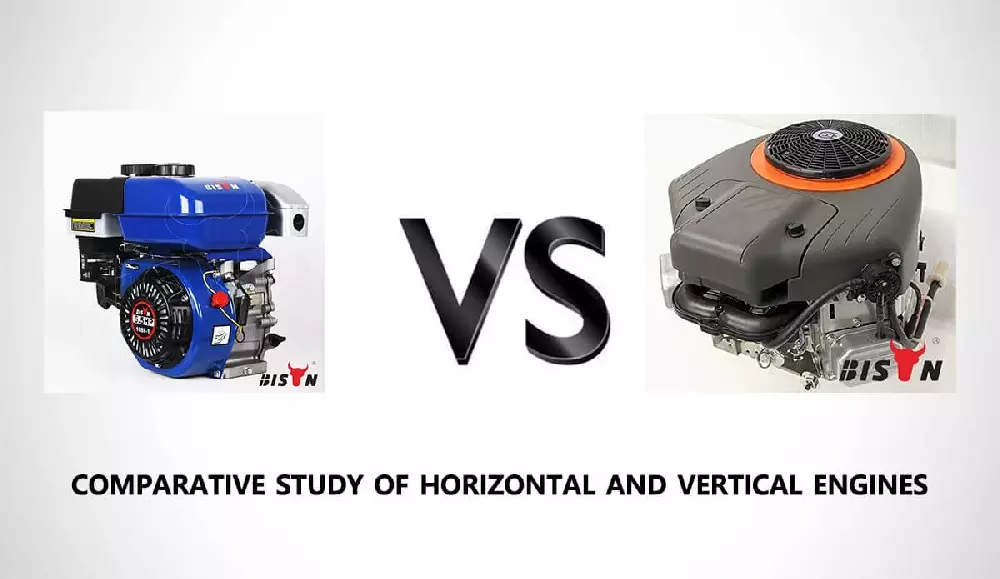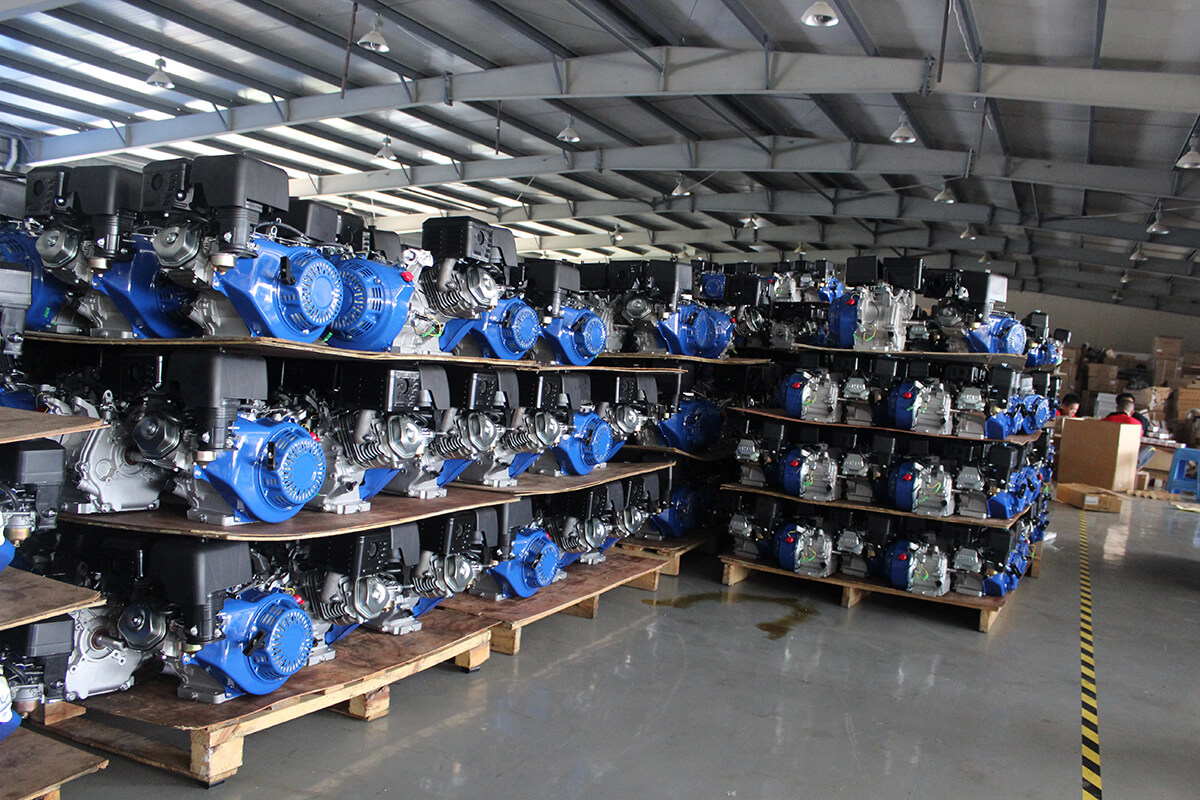comparative study of horizontal and vertical engines
2023-11-17
Table of content
In the realm of mechanical engineering, small engines play a crucial role in powering a wide array of machines and equipment. These compact powerhouses are classified based on several factors, one of which is their orientation.
Horizontal and vertical engines are two basic configurations with unique strengths and applications, leading to their diverse usage across various industries.
BISON focus in this article is to provide a comprehensive comparison between these two engine orientations. This guide will break down their definition, applications, and trade-offs, helping you make informed decisions for your needs.

What is a horizontal engine?
Horizontal engines are a type of internal combustion engine in which the crankshaft is positioned horizontally, parallel to the ground. This orientation is named for its horizontally placed piston that moves left and right.
Applications of Horizontal Engines
The versatility of horizontal engines has led to their widespread adoption in various industries and applications. Their compact design and efficient performance make them well-suited for a range of tasks. Here are some common applications of horizontal engines:
Brush cutters and garden equipment: Horizontal engines are extensively used in brush cutters, leaf blowers, and other garden equipment due to their ability to deliver consistent power and handle tough terrain.
Motorcycles: Their low center of gravity enhances stability and handling, while their efficient design contributes to fuel economy.
Generators: Horizontal engines are a common choice for powering generators, providing reliable and efficient electricity generation for various purposes.
Water pumps: Horizontal engines are often used in small pumps due to their compact design and efficient cooling capabilities.
Other Applications: Horizontal engines also find applications in leafblowers, pressure washers, air compressors, and various industrial machinery. Their versatility makes them a valuable asset in a wide range of industries.
Advantages of horizontal engines
Horizontal engines offer several advantages over other engine configurations, making them a popular choice for a variety of applications:
Lower center of gravity: The horizontal orientation of the crankshaft contributes to a lower center of gravity, which enhances stability and handling. This is particularly beneficial in applications where maneuverability is crucial, such as lawnmowers and motorcycles.
Efficient cooling: Horizontal engines typically provide better airflow and cooling compared to vertical engines. The horizontal orientation allows for more direct airflow over the engine components, promoting efficient heat dissipation and preventing overheating.
Compact design: Horizontal engines generally have a more compact design compared to vertical engines. This compact size makes them suitable for applications where space is limited, such as lawnmowers and generators.
Disadvantages of horizontal engines
Despite their numerous advantages, horizontal engines also have some potential drawbacks:
Horizontal engines may require more careful oil maintenance.
There can be excessive wear at the bottom of the piston and cylinder liner where the cylinder liner supports the engine because the cylinder liner carries the piston's weight.
The horizontal orientation might not be suitable for all types of machinery, particularly those requiring vertical force.
What is a vertical engine?
Vertical engines are internal combustion engines in which the cylinders are arranged in a vertical orientation. Vertical engines are a distinct type of engine where the crankshaft is oriented vertically, and the piston moves up and down.
Vertical engines are typically classified according to the number of cylinders they have, with single-cylinder, two-cylinder, and four-cylinder vertical engines being the most common.
Applications
This configuration results in a compact and efficient design. Which makes them particularly well-suited for applications that require vertical force or power. Vertical engines are primarily used in:
Automotive: Vertical engines are the most common type of engine used in automobiles. They are found in everything from small hatchbacks to large SUVs.
Ride-on lawnmowers: Vertical engines are often used in lawn and garden equipment, such as ride-on lawnmowers, larger garden tractors.
Industrial equipment: Vertical engines are also used in a variety of industrial applications, such as pumps, Industrial-strength generators.
What are the advantages of the vertical engine?
Improved oil circulation: Vertical engines benefit from gravity-assisted oil circulation, ensuring better lubrication and increasing the longevity of the engine. This is because gravity helps to pull the oil down into the crankcase, where it can be circulated throughout the engine.
Power delivery and stability: Vertical engines often exhibit a more stable power delivery, especially in high-torque applications. The vertical alignment allows for a more direct transfer of power from the engine to the load, minimizing energy losses and maximizing efficiency.
Disadvantages
Despite their many advantages, vertical engines also have some potential disadvantages, including:
Limited space: Vertical engines can require more space than other engine configurations, such as horizontally opposed engines. This can be a problem in applications where space is limited.
Their design might not be as stable as horizontal engines, potentially increasing the risk of tipping over.
Comparing horizontal and vertical engines
Efficiency comparison
When it comes to performance efficiency, both engine types have their strengths. However, horizontal engines are known for their efficiency, especially in applications where a horizontal layout allows for better weight distribution and balance. These engines often have a lower center of gravity, which can contribute to stability and efficiency. Vertical engines might be less efficient in terms of weight distribution, but they can be effective in certain applications, such as small space requirements or where a vertical design aligns with the overall system design.
Maintenance comparison
Maintenance requirements can vary depending on the specific engine model and application. Generally, horizontal engines might be easier to access for routine maintenance, which can contribute to lower maintenance costs. Vertical engines might be more challenging to access, especially in applications where space constraints limit accessibility. This could potentially lead to higher maintenance costs.
Space requirements
Horizontal engines are more compact than vertical engines. This is because the cylinders in a horizontal engine are laid out side-by-side, while the cylinders in a vertical engine are stacked on top of each other. Horizontal engines are often more space-efficient, making them suitable for applications where space is limited. However, vertical engines can be advantageous in applications where a vertical design aligns with the available space or specific design requirements.
Cost comparison
The cost of an engine can vary widely based on its specifications, brand, and intended use.
Horizontal engines are often considered cost-effective due to their widespread use, ease of manufacturing, and versatility in various applications. The competition among manufacturers for horizontal engines can contribute to reasonable pricing.
Vertical engines may be more specialized and less common in certain applications, potentially leading to higher manufacturing costs. However, in scenarios where a vertical design is necessary, the overall system cost considerations could balance out.
When engineers choose an engine, they decide the orientation of the crankshaft based on what makes the most sense to power the equipment. For example, When utilized in a walk-behind mower, a vertical shaft engine's blade can be mounted directly to the driving shaft. In contrast, a horizontal shaft may be bolted directly to the drive shaft in a water pump or pulley used on an impeller.
Conclusion
There is no one-size-fits-all answer to the great debate of horizontal versus vertical engines. The choice ultimately boils down to the specific demands of your project. Factors such as available space, cooling requirements, maintenance ease, and cost should all play a role in your decision-making process.
Remember, the right engine orientation can make a significant difference in the performance and longevity of your machinery. By understanding the merits of each configuration, you are empowered to make a decision that seamlessly aligns with your engineering goals. For further guidance or assistance in making this critical choice, don't hesitate to reach out to our team of experts.
Unleash the Power of BISON Engines
In the heart of every powerful machine lies an even more powerful engine. At BISON, we manufacture such engines - robust, reliable, and ready to rev up your business.
As a leading engine manufacturer in China, we offer both horizontal and vertical engines that are versatile enough to power generators, pressure washers, water pumps, and various garden equipment. Our products aren't just engines, they're an assurance of quality and performance.
What sets BISON apart? Every single one of our engines has passed rigorous market tests, ensuring they can withstand demanding conditions and deliver consistent performance. From small gasoline engines used in generators and stationary pumps to air-cooled diesel engines ranging from 4HP to 15HP, our engines are built to commercial-grade standards.
But we don't just cater to the masses. We understand that businesses have unique needs, especially those with large-volume purchasing requirements. At BISON, we're ready to meet those needs head-on with our production capabilities and commitment to quality.
So why wait? Power your business with BISON. Get in touch with us today and discover the difference a superior engine can make.

